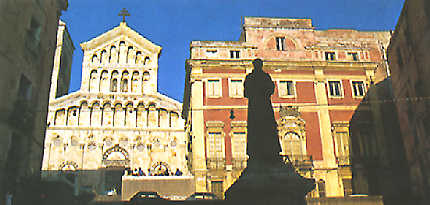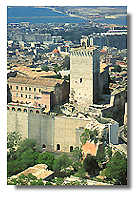
The Castello
neighborhood is the first area to visit in Cagliari. It is the city's ancient fortification.
The historic neighborhood is still partially enclosed by the bastioned walls. Two
medieval towers in white stone stand along the bastion enclosure along with two city gates that escaped demolition during the 19th century. The Castello itinerary
begins at the S.Pancrazio (s'Avanzada)
entrance or from the Porta dei Leoni, and follows the intricate web of Spanish-influenced streets.
Monuments:
The itinerary starts with the district's churches: first, the Cathedral, and the 16th
century church of the Purissima in via Lamarmora. The churches of Santa Maria del
Sacro Monte di Pietà, Santa Croce and that of San Giuseppe are in the lower part
of the neighborhood. Some of them are closed for restoration work. Once its political, religious
and administrative center, the city's more noble buildings are located in Castello.
Near the Cathedral are the former City Hall, the Viceregal Palace, and the Archbishop's Palace. Farther away are the Seziate, the Arsenal, today transformed into the
Cittadella dei Museums (Citadel of Museums), and moving down, the Belgrano Palace, home to the city's University.
Many other private residences bear witness to an aristocracy that was tenaciously
attached to the places of its history.
Museums:
Castello houses the most important artistic treasures of the city, in two museum
sites. The Cittadella dei Museums is home to four separate collections.
National Archaeological Museum:
This rich collection of objects and other artifacts contains many high quality pieces.
The succession of the island's ancient cultures is reconstructed through the exhibition
of ceramics and pre-nuragic statuettes, copper ingots, nuragic bronzes and ceramics, inscriptions, Phoenician tomb furnishings and ceramics, inscribed headstones
(one of the world's most important collections), and splendid Punic jewelry. Rich
ceramics, terra-cotta, glass objects, statues, Roman sarcophagi, and gold jewelry
dating from the High Medieval period, as well as artifacts from the Tuvixeddu and Pula necropolises
(objects produced by the Phoenicians, or imported from Greece, Italy, and Spain)
are particularly interesting
|







